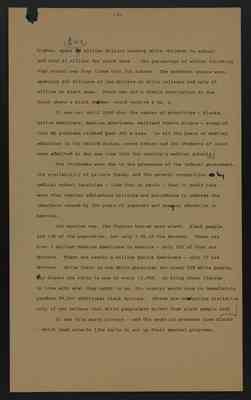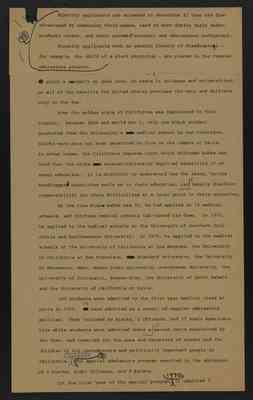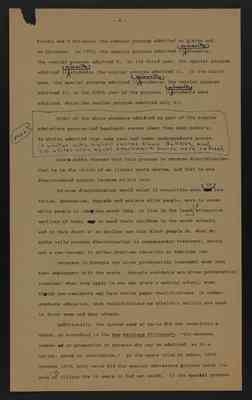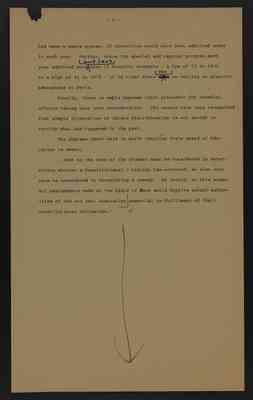Pages
1
-1-
Not everyone who wants to can become a doctor on in the United States today.
In 19735, 26,367 potential doctors were turned down by American medical schools. One of them was named Alan Bakke.
In a suit that has reached the United States Supreme Court. Bakke charges that he was denied admission at the University of California at Davis solely because of his race.
He charges that a special program for disadvantaged students - begun in 1970 - caused the admission of 16 minority students whose [illegible] academic qualification were less than his, and that denial violated his rights under the equal protection casue of the United States Constitution.
The university has answered this charge by arguing that only a race-conscious admissions policy can help overcome the imbalance between white and non-white physicians in California and the United States.
Because non-white students, as a class, do less well on standardized tests that white students do, any admissions policy which does not consider race will result in nearly all-white student bodies in American medical schools.
When the special admissions program was begun at UC Davis in 1970, Blacks were 2..6 % of all medical school enrollments. The same proportion as in 1950, twenty years earlier. In fact, since the Black population has increased faster than the number of Black physicians, there whre actually fewer Black doctors per thousand in 1970 than there were in 1948.
At the end of the 1960s, most American medical schools began special efforts to attract minority students. The need for such programs was evident.
In 1945, five years after Alana Bakke was and were born, the Southern states where most Black people lived then were spending twice as much to educate white children as is they spent for Black ones. It They paid four times as much for white school plants, paid white teacher salaried 30%
2
-2-
higher, spent $42 $2 million dollars bussing white children to school and only $1 million for Black ones. The percentage of whites finishing high school was four times that for Blacks. The southern states were spenging $86 millions of tax dollars on white colleges and only $5 million on Black ones. There was not a single institution in the South where a Black student could receive a PH. D.
It was not until 1968 that the number of minorites - Blacks, Native Americans, Mexican Americans, mainland Puerto Ricans - accepted into MD programs climbed past 200 a year. In all the years of medical education in the United States, never before had 200 students of color been admitted at any one time into the country's medical schools.
The increases were due to the pressures of the federal government, the availability of private funds, and the general recognition by medical school faculties - like that at Davis - that it would take more than regular admissions policies and procedures to redress the imbalance caused by 200 years of separate unequal education in America.
Put another way, the figures become more stark. Black people are 13% of the population, but only 2.6% of the doctors. There are over 5 million Mexican Americans in America - only 250 of them are doctors. There are nearly a million Native Americans - only 72 are doctors. While there is one white physician for every 538 white people, for Blacks the ratio is one to every 13,888. To bring these figures in line with what they ought to be, the country would have to immediately produce 29,000 additional Black doctors. (These are comforting statistics only if you believe that white people are sicker than Black people are)
It was this sorry picture - and the mounting pressure from Blacks - which lead schools like Davis to set up their special programs.
3
3 Minority applicants are screened to determine if they are disadvantaged by examining their means, need to work during their undergraduate career, and their parents' economic and education background.
Minority applicants with no general history of disadvantage - for example, the child of a Black physician - are placed in the regular admissions program enjoy a monoploy on good jobs, on seats in colleges and universities, on all of the benefits the United States promises the many and delivers only to the few.
Even the golden state of California was implicated in this bigotry. Between 1866 and World War I, only one black student graduated from the University's medical school in San Francsico. Blacks were once not even permitted to live on the campus at Davis. In other cases, the California Supreme court wich affirmed Bakke has held that the state unconstitutionally deprived minorities of an equal education. It is difficult to understand how the state, having handicapped minorities early on in their education can6 legally disclaim responsibility for their difficulties at a later point in their schooling.
By the time Alan Bakke was 32, he had applied to 13 medical schools, and thirteen medical schools had turned him down. In 1972, he applied to the medical schools at the University of Southern California and Northwestern Uuniversity. In 1973 , he applied to the medical schools at the University of California at Los Angeles, the University of California at San Francisco, Stanford University, the University of Minnesota, Mayo, Wayne State University, Georgetown University, the University of Cincinnati, Bowman-Gray, the University of South Dakota and the University of California at Davis.
100 students were admitted to the first year medical class at Davis in 1973. 79 were admitted as a result of regular admissions policies. They included no Blacks, 2 Chicanos, and 13 Asain Americans. Five white students were admitted under a secret quota maintained by the dean, and reserved for the sons and daughters of alumni and the children of big contributors and politically important people in California [following insert was taken from page 4] Eight of the white students admitted as part of the regular admissons program had benchmark scores lower than Alan Bakke's' 36 whites admitted the same year had lower undeergraduate scores. 15 whites with higher scores than Bakke's, and 20 whites with equal benchmarks scores were refused. 13 The special admissions program resulted in the admission of 6 Blacks, eight Chicanos, and 2 Asians.
(in the first year of the special program, 1970 it admitted 5
4
-4Blacks and 3 Chicanos; the regular program admitted no Blacks and no Chicanos. In 1971, the special program admitted 15 minority students; the regular program admitted 9. In its third year, the special program admitted 16 minority students; the regular program admitted 11. In it fourth year, the special program admitted 16 minority students; the regular program, admitted 15; in the fifth year of the program, 15 minority students were admitted, while the regular program admitted only 9.)
[following paragraph circled]
[in margin] page 3
Eight of the white students admitted as part of the regular admissions program had benchmark scores lower than Alan Bakke's; 36 whites admitted that same year had lower undergraduate scores. 15 whites with higher scores than Bakke's, and 20 whites with equal benchmark scores were refused.
Alan Bakke charges that this process is reverse discrimination, that he is the victim of an illegal quota system, and that he was discriminated against because of his race.
Reverse discrimination would exist if minorites were [illegible] to brutalize, dehumanize, degrade and enslave white people, were to cause white people to take the worst jobs, to live in the least9 attractive sections of town, and to send their children to the worst schools, and to face death at an earlier age than Black people do. What Mr. Bakke calls reverse discrimination is compensatory treatment, surely not a new concept in either American education or American law.
Veterans in Georgia are given preferential treatment when they seek employment with the state. Georgia residents are given preferential treatment when they apply to our own state's medical school, even though non-residents may have better paper qualifications. In undergraduate education, such qualifications as atheletic ability are used to favor some and deny others.
Additionally, the system used at Davis did not constitute a quota, or according to the New Heritage Dictionary. "the maximum number or proportion of persons who may be admitted, as to a nation, group or institution." In the years cited by Bakke, 1970 through 1974, only twice did the special admissions program reach its goal10 of filling the 16 seats it had set aside. If the special progeam
5
-5-
had been a quota system,16 minorities would have been admitted under it each year. Further, since the special and regular program each year admitted more and less than 16 minority students - a low of 12 in 1970 to a high of 31 in 1973 - it is clear there was no ceiling on minority admissions at Davis.
Finally, there is ample Supreme Court precedent for remedial efforts taking race into consideration. The courts have long recognized that simple elimination of future discrimination is not enough to rectify what has happened in the past.
The Supreme Court held in North Carolina State Board of Education vs. Swann:
- just as the race of the student must be considered in determining whether a Constitutional violation has occured, so also must race be considered in formulating a remedy. To forbid, at this stage, all assignments made on the basis of race would deprive school authorities of the one tool absolutley" essential to fulfilment of their constitutional obligation."




